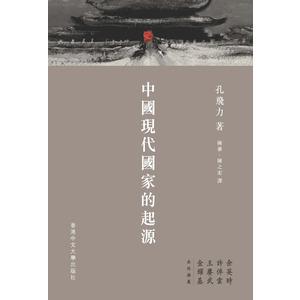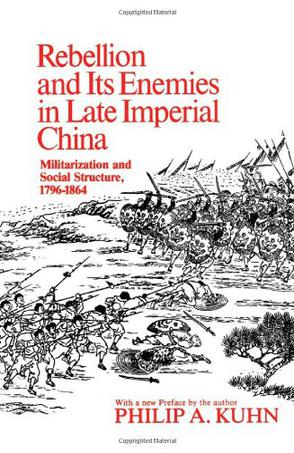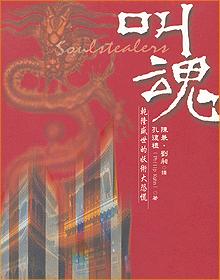-

孔飞力中国学研究
《孔飞力中国学研究》主要环绕孔飞力撰写的学术著作展开研究。基本思路是:从方法论上,遵循史学史与史学理论研究的一般方法,分析孔飞力中国近代史研究的基本历程。其二,运用科学的辩证思维方法,历史与逻辑、分析与综合、归纳与演绎相结合,力图在阐述孔飞力各个阶段成果的基础上,概括孔飞力的中国史观、中国史研究特色、方法,评价其学术地位和影响。其三,借鉴运用多学科的研究方法。由于孔飞力的历史研究借鉴了社会学、政治学、人类学、心理学等多门社会科学的研究方法,因此,运用相关的社会科学的方法和理论去研究是必要的。 -

中國現代國家的起源
中國現代國家的形成在何種意義上是一種「中國的」過程?本書認為,早在鴉片戰爭之前,中國內部就面臨著諸多根本性問題上的深刻危機。而如今這個「現代國家」,是兩個世紀以來對於這些內部挑戰不斷回應的結果。作者探討的正是在其形成過程中,中國本土提供的知識資源,即「現代性」的中國經驗。 在本書中,作者分別從政治參與、政治競爭與政治控制三個角度入手,探索「現代國家」在中國形成和發展的「根本性議程」:在政治參與的拓展與國家權力之間的關係問題上,作者重新審視魏源基於經書典章的傳統所提出的思考;在探討公共利益是否能同政治競爭相協調的問題上,回顧晚清改革家馮桂芬的非正統建議在當時官僚中所引起的反應;面對調和國家財政需求同地方社會需要的問題,對比了清政府與共產黨政府通過政治控制所做的不同努力和試驗。 作者認為,中國「現代性」的構建,包括這個現代國家的實現若成為可能,所根據的將不是西方的路徑,而是中國自己的條件與經驗。而中國的「現代國家」經驗,不僅與中國有關,也具有普世意義。 「一位在西方世界首屈一指的中國歷史專家所寫的關於東方古老國家的偉大著作。」 ——魏斐德,《紐約書評》雜誌 「本書對於專制統治的原動力做了細緻、強有力卻依然十分準確而又得體的探討。」 ——「列文森中國研究最佳著作獎」評語 -

Rebellion and Its Enemies in Late Imperial China
-

Chinese Among Others
In this book, distinguished historian Philip A. Kuhn tells the remarkable five-century story of Chinese emigration as an integral part of China's modern history. Although emigration has a much longer past, its "modern" phase dates from the sixteenth century, when European colonialists began to collaborate with Chinese emigrants to develop a worldwide trading system. The author explores both internal and external migration, complementary parts of a far-reaching process of adaptation that enabled Chinese families to deal with their changing social environments. Skills and institutions developed in the course of internal migration were creatively modified to serve the needs of emigrants in foreign lands. As emigrants, Chinese inevitably found themselves "among others." The various human ecologies in which they lived have faced Chinese settlers with a diversity of challenges and opportunities in the colonial and postcolonial states of Southeast Asia, in the settler societies of the Americas and Australasia, and in Europe. Kuhn traces their experiences worldwide alongside those of the "others" among whom they settled: the colonial elites, indigenous peoples, and rival immigrant groups that have profited from their Chinese minorities but also have envied, feared, and sometimes persecuted them. A rich selection of primary sources allows these protagonists a personal voice to express their hopes, sorrows, and worldviews. The post-Mao era offers emigrants new opportunities to leverage their expatriate status to do business with a Chinese nation eager for their investments, donations, and technologies. The resulting "new migration," the author argues, is but the latest phase of a centuries-old process by which Chinese have sought livelihoods away from home. -

Origins of the Modern Chinese State
What is “Chinese” about China’s modern state? This book proposes that the state we see today has developed over the past two centuries largely as a response to internal challenges emerging from the late empire. Well before the Opium War, Chinese confronted such constitutional questions as: How does the scope of political participation affect state power? How is the state to secure a share of society’s wealth? In response to the changing demands of the age, this agenda has been expressed in changing language. Yet, because the underlying pattern remains recognizable, the modernization of the state in response to foreign aggression can be studied in longer perspective. The author offers three concrete studies to illustrate the constitutional agenda in action: how the early nineteenth-century scholar-activist Wei Yuan confronted the relation between broadened political participation and authoritarian state power; how the reformist proposals of the influential scholar Feng Guifen were received by mainstream bureaucrats during the 1898 reform movement; and how fiscal problems of the late empire formed a backdrop to agricultural collectivization in the 1950s. In each case, the author presents the “modern” constitutional solution as only the most recent answer to old Chinese questions. The book concludes by describing the transformation of the constitutional agenda over the course of the modern period. -

叫魂
清乾隆三十三年,浙江省德清縣東面城牆的水門與城牆坍塌了,阮知縣僱用了一位名叫吳東明的石匠,吳石匠和它的班子開始了打木樁入河的繁重工作‧‧‧‧‧ 據他們說,石匠們需要將活人姓名寫在紙片上,貼在木樁,這樣會給大錘的撞繫添加某種精神的力量,人們稱之為「叫魂」。凡是因此而被竊去精氣的人,不是生病,便是死去。 一七六八年,中國悲劇性近代的前夕。 某種帶有預示性質的驚顫蔓延於中國社會:一個幽靈!一種名為「叫魂」的妖術!在華夏大地上盤桓。據說,術士們如果對受害者的名字、毛髮或衣物作法,便可使他發病,甚至死去,並偷取他的靈魂精氣,使之為自己服務。這樣的歇斯底里,影響到了十二個大省份的社會生活,從農夫的茅舍到帝王的宮邸均受波及。 這是一個看來正值盛世的時代。但它的種種狀況,是否已在黑色妖術的掩飾下,發出了非如此便不能為人感知的未來警告?時處十八世紀,倚仗武力而來西方人未出現,生活在那個時代的人們,是否已在為中國近代社會創造著條件?